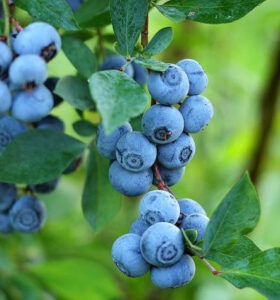Conilopide Blueberry

The Conilopide Blueberry is a shrub from 1.5 to 6m high, which differs from the American blueberry due to the little need for cold. Due to this peculiarity, the conilopid adapts to warm climates and today finds in many areas of Southern Italy favorable soil and climatic conditions for its cultivation, while in Northern Italy it must be planted only in mild climate environments.
The conilopid is also used as an ornamental plant. In fact, 1.8-3 m high hedges can be formed, particularly appreciated for their color and beauty in every season of the year.
GROUND
Unlike American blueberries, they do not need an acidic soil, it is only important that it is well drained, fresh and rich in humus, so it is essential to be well aware of the characteristics of the bottom where you want to plant them.
They are lovers of the sun which allows the fruits to obtain a high sugar content, but in an environment that is not excessively exposed, and they require good exposure to light to allow for better flowering and, consequently, a greater harvest.
FLOWERS AND FRUITS
In spring the plants are covered with white-pink flowers, in summer the fruits, with a round shape and firm to the touch, form a delicious blue spot, similar to the American blueberry. In autumn the leaves and branches take on reddish hues which they then maintain even in the winter period.
The conilopid blueberry will not lose its leaves like the American blueberry, but will tend to have them throughout the winter period, giving us shades of red.
It is necessary to plant cultivars that are able to fertilize each other and to place some hives in the blueberry grove to ensure sufficient cross-pollination. It is generally recommended to plant a row of the pollinator alternating with two of the main cultivar.
USE AND HEALTHCARE
Easily stored in the freezer, they are eaten fresh, in fruit salads, pastries, jams; its use in the pharmaceutical and parapharmaceutical industry is important.
Among the berries, the conilopid blueberry, together with the American blueberry, is certainly the most important from a health point of view: in addition to the exquisite flavor, there are many properties that make it count among the main agricultural foods. Vitamin C, carotenoids, catechitin tannins (molecules with astringent, hemostatic, antibiotic, antidiarrheal and anti-inflammatory properties), pectins are some of the substances contained in blueberry fruits.
But it is the presence of anthocyanins, powerful antioxidants and known for their capillarotropic properties, make this small fruit a panacea for the body and the cardiovascular system, in particular.
By capillarotropic properties we mean the characteristic of the active ingredients, contained in a substance or food, capable of improving the resistance and functionality of the capillaries.
In any pharmacy we will find products derived from the fruit of the blueberry for the treatment, prevention and strengthening of the walls of the blood vessels.
PRUNING AND COLTURAL CARE
It is very important that the characteristics of the soil meet the needs of the plant. After this premise, the description of the necessary care is also simple because you will have a strong and vigorous plant without major interventions. The first years after planting the plant will work a lot of roots, while the aerial apparatus will give the impression almost suffering.
In this period, about 1/2 years, the production will be modest as well as the pruning that will take place with the cutting of the low side branches and the total removal of the weaker branches.
After this period, we will proceed with the thinning of the weakest vegetations starting from the base and the cutting of damaged or broken branches and on the remaining ones we will proceed with back cuts up to the most vigorous side branches.
In addition, those branches that, although healthy and beautiful, have a disordered and disordered growth will be cut.
Having a very superficial root system, irrigation is very important, especially in the period from flowering to fruit harvest.
Be careful not to let the water stagnate, which would lead to the formation of fungi that would rot the roots.
To retain moisture, and at the same time keep the soil clean and acidic, mulching with acid peat or pine needles or beech leaves is recommended.
With the precautions described above, fertilizations should not be used, but if deficiencies are found, a low nitrogen content ternary fertilizer containing the main microelements at the beginning of the season will certainly be effective.
Manure should never be used, even if it is very mature: the plant would suffer from iron chlorosis and as a result, it could even die.
There are few parasites: the most dangerous is the oziorinco (Otiorhyncus ssp), a small beetle that gnaws at the leaves and lays its eggs on the ground as an adult; the resulting larva eats the roots and, much more seriously, gnaws the collar of the plant causing its death.
With particular atmospheric conditions, attacks of gray mold (Botrytis) are possible on fruits close to ripening, but since they cannot be treated with pesticides, the only solution is the manual removal of the affected fruits.
Please note that the collaborators of the PRANDINI nurseries are available for advice on plant density, training system, crop choice and even phytosanitary assistance for new production plants, even of modest size.
